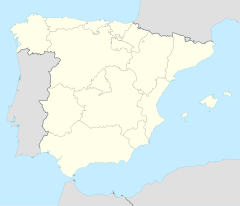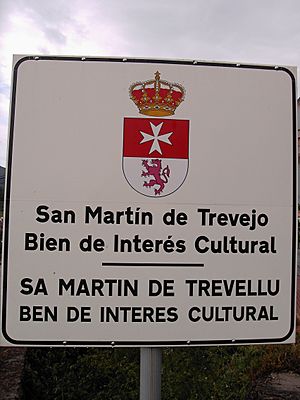Fala language facts for kids
Quick facts for kids Fala |
|
|---|---|
| Native to | Spain |
| Region | NW Extremadura |
| Native speakers | (11,000 cited 1994)e18 |
| Language family | |
| Early forms: |
Old Latin
|
Fala is a special language spoken in Spain. Its name means "Speech." Some people also call it Xalimego. It's a Romance language, which means it comes from Latin, just like Spanish or Portuguese.
About 10,500 people speak Fala. Most of them (around 5,500) live in a valley in northwestern Extremadura, close to the border with Portugal. The towns where Fala is spoken are Valverde del Fresno (Valverdi du Fresnu), Eljas (As Ellas), and San Martín de Trevejo (Sa Martín de Trevellu). These towns are in the Jálama valley, within the Sierra de Gata area.
People who speak Fala don't usually call it "Fala de Jálama" or "Fala de Xálima." Instead, they have their own names for their local way of speaking:
- In Eljas, they call it lagarteiru.
- In San Martín de Trevejo, they call it manhegu or mañegu.
- In Valverde del Fresno, they call it valverdeiru.
Contents
History of Fala
How Fala Started
Fala is a very old language. It began a long time ago, in the Middle Ages. At that time, people living near the border between the old Kingdom of Leon (in Spain) and Portugal spoke a mix of Portuguese and a language called Leonese.
Historians believe that the Jálama valley, where Fala is spoken, was a bit isolated. This might have helped the language stay unique. Over time, the borders between Spain and Portugal changed. This meant some towns that once belonged to one country ended up in another. Even though the countries changed, the people often stayed in their homes and kept their language.
Recent Times
In 1992, a group called Fala i Cultura was formed. Their goal was to create a common grammar for Fala and to celebrate "the day of our language" (u día da nosa fala). This special day is celebrated once a year in one of the three towns.
The first book written in Fala was published in 1998. It was a collection of short plays called Seis sainetes valverdeiros by Isabel López Lajas. After this, a government office started to take interest in Fala. They began to study it and held a special meeting about the language in 1999.
In 2000, Fala was officially recognized by the government of Extremadura as a "Bien de Interés Cultural." This means it's considered an important part of the region's culture and history. Today, most people in the Jálama Valley can speak Spanish, but they also use Fala at home and with friends. This makes them bilingual!
How People Use Fala
Experts have done surveys to understand how people use Fala.
In 1992, a professor named José Enrique Gargallo Gil asked people if they spoke Spanish with their families.
- In San Martín de Trevejo, about 14% of people used Spanish with family.
- In Eljas, only about 6% used Spanish with family.
- In Valverde del Fresno, about 20% used Spanish with family.
This shows that most families preferred to speak Fala at home.
Another survey in 1993 asked people in San Martín de Trevejo what they thought Fala was:
- 13% thought it was a dialect of Spanish.
- 20% thought it was a dialect of Portuguese.
- 67% thought it was its own language.
A study in 1994 found that 80% of people learned Spanish at school. But when it came to parents speaking with their children:
- 100% of parents in Eljas used Fala.
- 85% of parents in San Martín used Fala.
- 73% of parents in Valverde used Fala.
This shows that Fala is still very much alive in daily family life.
Sounds of Fala
Just like any language, Fala has its own special sounds. These are called phonemes.
Consonant Sounds
| Bilabials | Labiodentals | Dentals | Alveolars | Postalveolars | Palatals | Velars | |
|---|---|---|---|---|---|---|---|
| Nasals | m | n | ɲ | ŋ | |||
| Stops | p b | t d | k g | ||||
| Affricates | t͡ʃ | ||||||
| Fricatives | (β) | f v | (ð) | s z | ʃ ʒ | (ɣ) | |
| Trills | r | ||||||
| Flaps | ɾ | ||||||
| Approximants | j | w | |||||
| Laterals | l | ʎ |
Vowel Sounds
| Front | Back | |
|---|---|---|
| High | i | u |
| Mid-high | e | o |
| Low | a | |
Fala Alphabet
Here is one way the Fala alphabet can be written. It uses 23 letters.
| Big Letters | |||||||||||||||||||||||||
|---|---|---|---|---|---|---|---|---|---|---|---|---|---|---|---|---|---|---|---|---|---|---|---|---|---|
| A | B | C | D | E | F | G | H | I | J | L | M | N | O | P | Q | R | S | T | U | V | X | Z | |||
| Small Letters | |||||||||||||||||||||||||
| a | b | c | d | e | f | g | h | i | j | l | m | n | o | p | q | r | s | t | u | v | x | z | |||
Comparing Words in Fala
Here are some words in Fala, compared to other languages like Latin, Galician, Portuguese, and Spanish. You can see how they are similar or different!
| Latin | Galician | Fala | Extremaduran | Portuguese | Spanish | English |
|---|---|---|---|---|---|---|
| hodie | hoxe | hoxii | hoy | hoje | hoy | today |
| locus | lugar | lugal | lugar | lugar | place | |
| dicere | dicir | izil | decir | dizer | decir | to say/to tell |
| oculus | ollo | ollu | oju | olho | ojo | eye |
| aqua | auga | agua | áugua | água | agua | water |
| creāre | crear | crial | crial | criar | crear | to create |
Learn More
- Galician-Portuguese
- Leonese language
- Portuguese language
- Galician language
- Extremaduran language
- Castúo
- Portuñol
See also
 In Spanish: Fala (valle de Jálama) para niños
In Spanish: Fala (valle de Jálama) para niños



